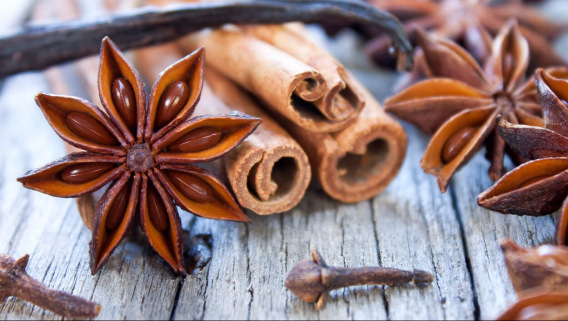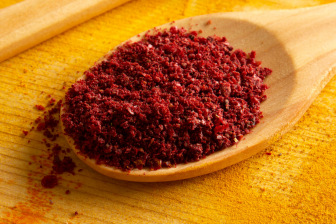Top 5 Herbs and Spices to Boost Your Holiday Meals
Health & WellnessWritten by Tejal Parekh | Edited by Amy Edel

With the holiday season upon us, traditional favorite festive meals can be an enjoyable way for you to find needed high-calorie foods and feel enticed to eat. Weight loss and lack of appetite are particular nutrition challenges for malignant mesothelioma patients. Holiday dishes are also a good time to integrate potent sources of antioxidants.
When thinking about foods that are protective, we know fruits and vegetables should be our ‘go to’ menu items. But spices are little nutrient powerhouses and are a must for anyone looking for added protection against viruses, heart disease and cancer.
We’re narrowing our list to the top 5 spices with very high concentrations of antioxidants. We recommend you give these a try, not only over the holidays, but also throughout the year!
Cloves
Cloves come from the flower buds of an evergreen tree native to Indonesia. The name ‘clove’ comes from the Latin word for nail, Clavus, because of its shape. Cloves have a warming, sweet, spicy flavor and a little goes a long way.
They’re used in many international foods like Mediterranean, Indian and Mexican. You’ll also find cloves added to pumpkin pie and gingerbread, adding a real depth of flavor.
Try adding some ground cloves to your next smoothie, rice dish or muffin recipe. You can also use whole cloves in cooking and remove before eating.
Cinnamon
Cinnamon has long been used as a spice in many regions of the world including China and India. It comes from the bark of the cinnamon tree.
Like cloves, it has a warming, sweet flavor, but it isn’t as strong or fiery so it is easy to use in a number of dishes. Cinnamon can be bought in sticks or ground.
You can use the sticks and steep in hot water for a delicious tea or use ground cinnamon in baking. Add some when roasting sweet potatoes or sprinkle a little on top of your morning oatmeal.
Oregano
Bold and earthy, oregano is a potent antioxidant and has many uses in cooking. This herb belongs to the mint family and has been used for thousands of years.
This is an easy to grow herb but is readily available in any grocery store in its dried form. Try adding a little to a homemade salad dressing, use in pizza sauce and add some to baked chicken or potatoes.
Sumac
Sumac is most commonly used in Middle Eastern cuisine. Sumac berries are dried and ground into a powder, which is how you’ll find it in the store.

Rated as having one of the highest levels of antioxidants, sumac is worth exploring. If you don’t see sumac at your usual grocery store, a store that carries more Middle Eastern foods should have it.
With its lemony flavor, it can be used as a rub on meats, in salad dressings and mixed with hummus (chick pea dip). Add sumac to some olive oil, lemon juice and garlic for a simple dressing that you can use on a green salad.
Peppermint
Peppermint is another herb that is very easy to grow at home. It has been used for centuries to treat issues related to digestion.
Many people use peppermint tea as a digestive aid after meals. The leaves can be steeped in boiling water for 5 minutes to create a tea.
Peppermint leaves can also be added to a salad. Try chopping the leaves and adding them to yogurt and cucumbers for a delicious dip.
Holiday Recipes with Herbs and Spices
There are many ways to enjoy these healthy herbs and spices to add flavor and nutrients to holiday meals. Trying them now in festive dishes may inspire you to incorporate them into your menu all year.
These recipes add in some healthy touches for the holidays:
Cinnamon Green Tea
This a great alternative to a hot apple cider
Ingredients
- 1 small bunch mint (preferably peppermint or spearmint), about 15 sprigs
- 4 3-inch cinnamon sticks
- 1-2 thin slices of fresh ginger
- 6 cups cold water
- 4 bags green tea, regular or decaffeinated
- 6 tablespoons 100% apple juice concentrate (or to taste)
Directions:
- Place mint, cinnamon sticks and ginger in a large saucepan. Add water, cover the pot and bring to a boil. Reduce heat and simmer for 3 minutes. Remove from heat.
- Add tea bags and steep for 5 minutes.
- Remove tea bags, mint, ginger and cinnamon sticks, reserving the sticks. Sweeten the hot tea to taste with apple juice. Pour into mugs; add cinnamon sticks for garnish and serve.
Recipe from The American Institute for Cancer Research
Crispy Parmesan and Oregano Roast Potatoes
Potatoes are a must with any holiday meal and the added oregano boosts the antioxidants and flavor!
Ingredients
- 4 pounds small red-skinned potatoes, halved or quartered
- 3 tablespoons olive oil, plus extra for brushing
- ⅓ cup parmesan (or dairy free, plant-based alternative)
- 1 rounded teaspoon mustard powder
- Pinch cayenne pepper
- 1 teaspoon. dried oregano
Directions
- Heat the oven to 400 F. Put the potatoes in a large pan of boiling, salted water and cook for 7-8 minutes until not quite cooked. They should still be quite firm when pierced with the tip of a sharp knife. Drain well.
- Meanwhile, drizzle the oil into 1-2 large roasting tins (the potatoes need enough room to fit in a single layer) and evenly grate over the parmesan to cover the base(s). The fine side of a box grater is best. Evenly scatter over the mustard powder, cayenne and oregano. Arrange the potatoes, cut-side down, on top of the cheese. Brush the potatoes with a little more oil and season well with salt. Roast in the oven for 45-50 minutes until the parmesan is golden and crisp and the potatoes have shrunk slightly and are crisp and tender.
- Remove the potatoes from the tin(s) using a palette knife or fish slice and transfer to a serving dish. Make sure you scrape up all the crispy browned bits of parmesan from the base. Serve straightaway.
Recipe from Delicious Magazine







